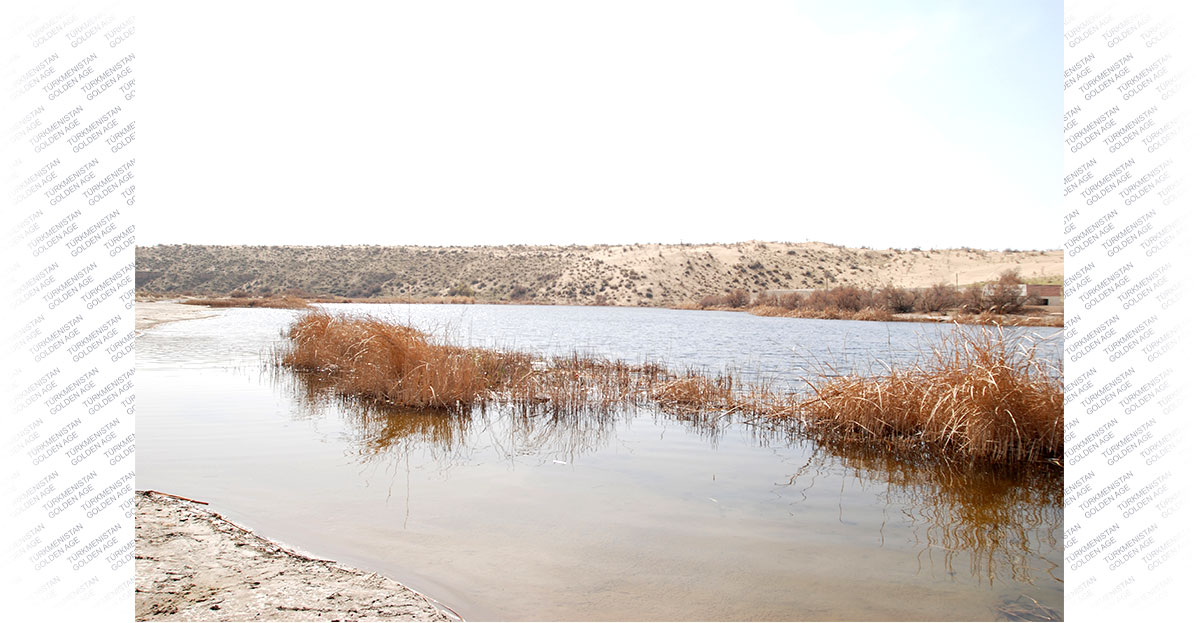The caravanbashy who drove caravans to Khiva and back to the Kopetdag and to the Caspian knew this river valley well, stretching from Sarykamysh to the Kelker salt marsh and further along the Aktam channel to the Balkhan Shore. On the caravan road there were wells with fresh water, and in the valley of Western Uzboy there were lakes with fresh and salt water, salt marshes and mineral mud. On the caravan trail behind the Adjiku bend near the oxbow Uzboy, travelers who were languishing with thirst, behind the sandy hillocks of the Low Karakum Desert, met a real miracle. These were the never-ending fresh water lakes - Topyatan, Karategelek and the pearl of the desert - Yaskhan Lake ...
Inhaling the evening coolness on the shore of a lake lost in the sands, many travelers wondered where this clean and pleasant-tasting water came from and how is it preserved? But none of them could have guessed that at this moment they are standing above a huge underground “reservoir” formed thousands of years ago, when the creator of the greatest desert in the world, the great Amu Darya, flowed here.
Scientists first started talking about the relict lakes of Uzboy, and first of all about Lake Yaskhan, as a source of drinking water at the end of the 19th - beginning of the 20th centuries. However, only in the middle of the last century, when engineering-geological and hydrogeological surveys began in the Priuzboy Karakum along the proposed route of the Main Turkmen Canal, it was reliably established that fresh water comes to Lake Yaskhan from a huge underground lens of fresh water, also called Yaskhan. For several years, hydrogeologist Nadezhda Grigorievna Shevchenko was engaged in a detailed study of the origin and existence of a giant underground aquifer in the central part of the Priuzboy Karakum Desert. Thanks to her perseverance and consistency, all issues related to this largest freshwater deposit were studied. She managed not only to determine the relict nature of fresh groundwater, but also the reason why these waters have been preserved for millennia.
For a long time, some scientists believed that the aquifers of this area are associated with the Kopetdag. They say that groundwater is fed from the side of the foothill plain. Others talked about the presence of deep underground aquifers with runoff towards the valley of the ancient river. Still others emphasized the priority of atmospheric moisture. But only the staff of the Uzbek Hydrogeological Party managed to solve the mystery of nature, which explored significant areas of the Karakum and Chilmamedkum areas, including those that were quite remote from Uzboy. They argued that fresh and salt lakes are the result of free drainage of groundwater into the Uzboy valley and their subsequent concentration. At the same time, the safety of the lakes was explained not only by their recharge from the underground lens, but also by the presence of a runoff, which ensures their flow.
It became clear that fresh water reserves are of great practical interest for large-scale water supply. It was found that fresh water occurs here in the form of a huge lens with a volume of about 10 cubic kilometers, on an area of about two thousand square kilometers. In the central part, the thickness of fresh water reaches about 80 meters, and in some points - over a hundred meters.
A few years later, a water intake was built on the lens area, which, since 1963, has been supplying water from a natural reservoir not only to the city of Balkanabat, but also to oil fields and rural settlements. For so many years now, from 16 to 29 thousand cubic meters of drinking water has been supplied daily through the pipeline for the needs of the city of oil workers. In total, over many years, more than a thousand wells have been drilled here - observation, prospecting, exploration and production. Today, more than fifty clusters of wells operate at the water intake (there are three wells in each cluster). The fact is that the fresh water in the lens from below is supported by salt water, and these horizons are not separated from each other by anything. Therefore, scientists V. Babushkin, I. Glazunov, N. Shevchenko proposed a coupled method for pumping fresh and saline water with two pumps at once, one of which pumps fresh water, and the other - saline water. This is done so that there is no mixing of fresh and salt water. Due to the introduction of new technology over the past years, the fresh water of the underground lens has not changed its chemical composition and degree of mineralization. It remains as tasty and soft as hundreds of years ago.
Vladimir Komarov







